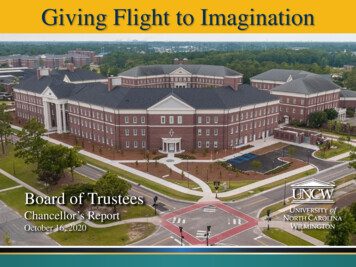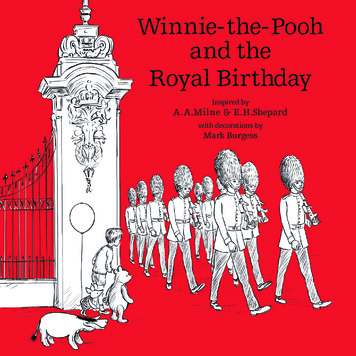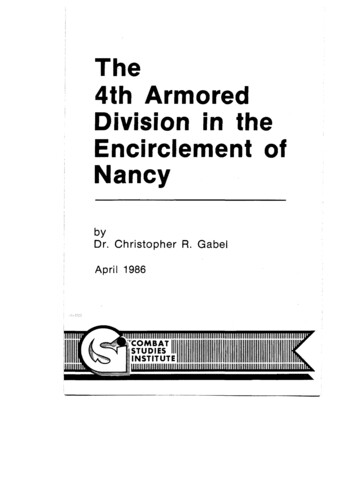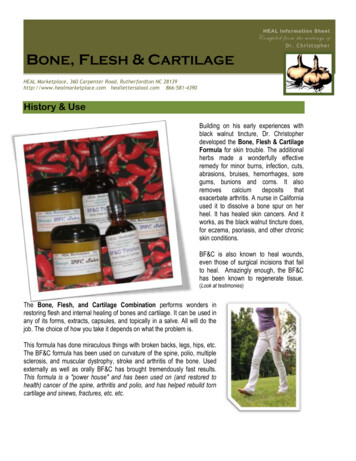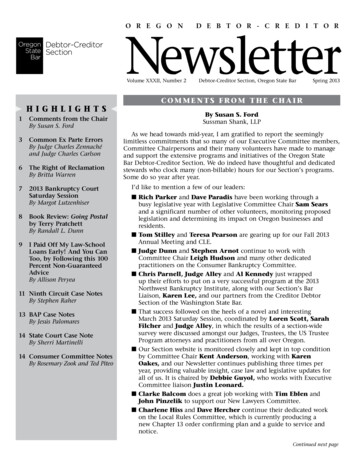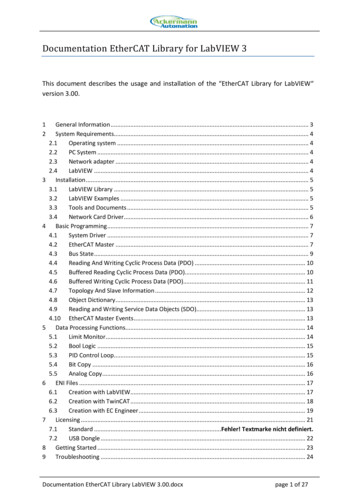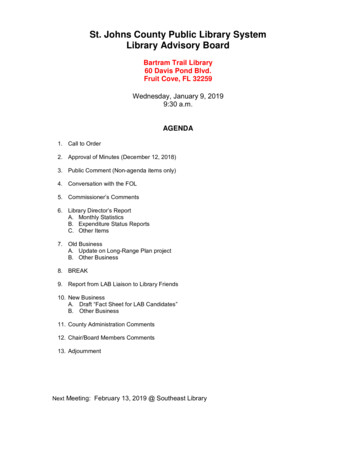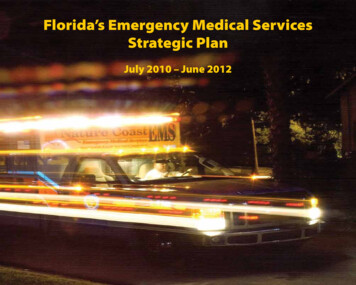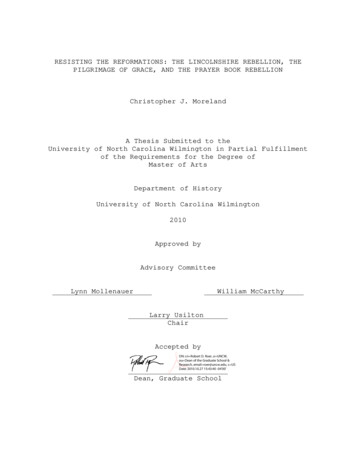
Transcription
RESISTING THE REFORMATIONS: THE LINCOLNSHIRE REBELLION, THEPILGRIMAGE OF GRACE, AND THE PRAYER BOOK REBELLIONChristopher J. MorelandA Thesis Submitted to theUniversity of North Carolina Wilmington in Partial Fulfillmentof the Requirements for the Degree ofMaster of ArtsDepartment of HistoryUniversity of North Carolina Wilmington2010Approved byAdvisory CommitteeWilliam McCarthyLynn MollenauerLarry UsiltonChairAccepted byDN: cn Robert D. Roer, o UNCW,ou Dean of the Graduate School &Research, email roer@uncw.edu, c USDate: 2010.10.27 15:43:40 -04'00'Dean, Graduate School
TABLE OF CONTENTSABSTRACT. iiiACKNOWLEDGEMENTS. ivDEDICATION. viINTRODUCTION. 1CHAPTER 1: THERE SHALL BE BUSINESS SHORTLY IN THE NORTH. 10CHAPTER 2: THE RUDE COMMONS OF LINCOLN. 25CHAPTER 3: PILGRIMS TRIUMPHANT, PILGRIMS DEFEATED. 34CHAPTER 4: POPISHLY AFFECTED PERSONS, CORNWALL 1549. 50CONCLUSION: FOR THE LOVE THAT YE BEAR. 61APPENDIXES. 65WORKS CITED. 80ii
ABSTRACTTraditional narratives of the English Reformation contendthat the religious innovations Henry VIII, and his son EdwardVI, instituted were widely accepted by the English people.Evidence of widespread resistance to the Henrican and Edwardianreformations suggest a counter narrative that complicates theprevailing discourse. For example, The Lincolnshire Rebellion,the Pilgrimage of Grace, and the Prayer Book Rebellion of 1549,all demonstrate that Catholic sympathies persisted throughoutthe reigns of Henry and his son.This study provides evidence that the primary motivationsfor resistance to the reformations were religious in nature.With regards specifically to the Lincolnshire Rebellion and thesubsequent Pilgrimage of Grace, the Dissolution of theMonasteries was undeniably the cause of rebellion. This studyalso argues that economic and religious factors were notmutually exclusive categories in this period of history and thatattempting to delineate such categories is anachronistic.Catholic sympathies continued far after the Dissolution ofthe Monasteries, the subjugation of the Pilgrimage of Grace, andthe death of Henry VIII. The Prayer Book Rebellion of 1549 inCornwall is further complicates the hegemonic view that theReformations were unopposed and inevitable.iii
ACKNOWLEDGEMENTSI am deeply appreciative to the many individuals whograciously assisted me in the preparation of this thesis. Iwould like to first thank my committee Chair Dr. Larry Usilton,for his guidance and inspiration throughout my undergraduate andgraduate career. I would be remiss to not mention my othercommittee members, Dr. Lynn Mollenauer and Dr. William McCarthywhose contributions to this thesis were equally invaluable,particularly with regards to the conclusion. I would be equallyremiss if I did not acknowledge Dr. David LaVere, for hisguidance, motivation, and administrative capabilities. I mustcommend Dr. Carol Ellis for correcting several grammaticalerrors and improving the flow of my writing. Dr. Diana Pasulkaand Dr. George Zervos of the Religion department provided mewith constant guidance and reassurance throughout the writing ofthis thesis and kept me from falling into despair. I am alsoindebted to Sue Cody of Randall Library and Sophie Williams ofInterlibrary Loan for their ability to track down even the mostobscure documents and volumes on this equally obscure subject. Iam also grateful to them and the rest of the Randall Librarystaff for their patience and understanding with regards to duedates and other administrative difficulties. The support of myfellow graduate students in the history department, includingiv
but not limited to, Michael Jenkins, Becky Zimmer, Nina LaFerla,and Sharad Shah, has been greatly appreciated. It goes withoutsaying that this thesis could not have been written without thefinancial and emotional support of my parents and my stepfather.I would like to specifically thank my father for the use of hisphotocopier, which saved me from an incredible amount of timeand frustration. I am also indebted to the staff of theDepartment of Academic Affairs at UNCW, and my formersupervisor, Dr. Johnson Akinleye, for providing me withemployment for several semesters. Additionally, I give thanks tomy many friends and supporters who I am not able to mention heredue to space restrictions.v
DEDICATIONTo my mother, Jeannie Schum Moreland Layton, my fatherRobert Lee Moreland, my stepfather Dr. Kenneth Earl Layton andto the memory of my grandmother Doris Schum.vi
INTRODUCTIONOctober 26, iting a conflict that seemed inevitable. On the north side,an army of nearly fifty-thousand men, under the command of aone-eyed lawyer named Robert Aske, seemed unperturbed by thedriving rain and miserable weather. 1 Fully decked in the panoplyof war underneath the banner of St. Cuthburt and the Five Pilgrimage of Grace stood ready to remove any resistance intheir path and march on London to present their grievances toHenry VIII.On the other side of the Don, the only substantial forcethat stood between the king and the Pilgrims was a paltry armyof five to eight thousand soldiers. 2 Led by the Duke of Norfolk,who was sympathetic to the religious grievances of the espreadingthrough their ranks and considered desertion. 3 Their loyalty was1Madeleine Hope and Ruth Dodds. The Pilgrimage of Grace and the ExeterConspiracy, (London: Frank Cass and Co., Ltd., 1915), 261; J.S Brewer, J.Gairdner and R.H. Brodie, “Preface”, Letters and Papers, Foreign and Domesticof the Reign of Henry VIII, (London, 1862), xii, 6.2Cardinal Francis Aidan Gasquet, Henry VIII and the English Monasteries. (NewYork: Freeport, 1972), 110; G.R Elton, Reform and Reformation, England 15601558, (Cambridge: Harvard University Press, 1977), 260.3Thomas Master, “Collectorum Liber Secundus, fol. 199, Liber 3,” in R.W.Hoyle’s “Thomas Master’s Narrative of the Pilgrimage of Grace,” NorthernHistory 21 (1985) : 71; Wilkes, Thomas G, “The Pilgrimage of Grace: A
upporter of religious innovations.Henry was facing the single greatest threat to his reign,and if he had not employed his trademark duplicity and cunning,the history of his rule would have been significantly altered. Adecade later, the people of Cornwall rose against the religiousinnovations of Edward IV and his regent, Protector Somerset.Changes in the liturgy, the dissolution of the chantries, andattacks on popular religious devotions drove Cornwall into itional fashion and eventually laid siege to Exeter.theThedisturbance sent shock waves throughout the country, and panicspread all the way to London. 4For most of the historiography of the Reformation, theseevents have been downplayed as minor insurrections with littleimpact on England’s history. 5 The existence of the rebellionssuggests that the English Reformations were not easily acceptedand were met with local resistance, particularly in the northand in Cornwall. In this study, I argue that the Catholic sanCatholic Interpretation of Popular Belief and the Northern Uprisings of 1536”M.A. Thesis, Armstrong Atlantic State University, 1996, 83.4B.L. Beer, “London and the Rebellions of 1548-1549”, Journal of BritishStudies 12, No. 1 (November 1972) : 25.5Dodds, Pilgrimage, 332; Burke, Hubert, Historical Portraits of the TudorDynasty and the Reformation Period, (John Hodges: Charing Cross, 1879),483.2
espiritual, economic, and social lives of the English people. Thesuppression of the church and the spoliation of the story,thePilgrimage of Grace, which confronted Henry with his greatestdomestic crisis. 6 Resistance to the Reformation continued afterthe death of Henry, resulting in the Prayer Book Rebellion of1549.This thesis contends that significant Catholic sympathiespersisted throughout the reigns of Henry VIII and his son,Edward as evidenced by the Lincolnshire Rebellion, thePilgrimage of Grace and the Prayer Book Rebellion.This workwill also demonstrate how resistance to the Reformation wasprimarily motivated by a network of relationships betweeneconomic factors, livelihood, and linguistic policy that wereall inextricable from religious concerns. Using a theoreticalframework that attends to the connections between religion andeconomic factors helps show how religious motivations werecentral to the rebellions. 76J.J. Scarisbrick, The Reformation and the English People (New York:Blackwell, 1984), 82; A.F. Pollard, Henry VIII (New York: Harper and Row,1966), 281.7In particular, Max Weber paved a way of defining religion as a network ofmutually informing social forces, including economic factors in his work, TheProtestant Work Ethic and the Spirit of Capitalism. Robert Orsi, acontemporary historian of religion also uses this framework in Between Heavenand Earth: The Religious Worlds People Make and the Scholars Who Study Them.3
Historiography and MethodologyUnderstanding the historiography of the Reformation, andthis topic in particular, is crucial to an appreciation of rhistorical discourse has essentially forgotten the events of relymerit a footnote in most textbooks or popular histories of theReformation period. For the amateur historian, the Reformationwas a fait accompli in which the English people were eitherapathetic about religious change, or embraced it wholeheartedly.This typical view is described by Norman Jones as “once upon hmen.they yearned for the liberty of the Gospel. ThenGood King Harry gave them the Protestant nation for which theylonged.” 8Such arguments have been supported by scholars of what canbe described as the “Whig-Protestant” narrative of history. Whighistory states that change is usually for the better, and thateverything that has transpired in English history is one stepcloser toward the eventual creation of a free, prosperous, anddemocraticEngland. 9Forthehistorians8oftheWhigschool,Norman Jones, The English Reformation: Religion and Cultural Adaptation,(Malden: Blackwell, 2002), 1.9Candice Ingrid Lines, “The Old World Anew : Nostalgia and the Constructionof Resistance in the Reign of Henry VIII”, PhD Thesis, University ofWisconsin, 2001, 4.4
superstitions of Popery and the dawn of an independent Englishnation. Enoch Powell, famous for his “Rivers of Blood” speech,succinctly described this train of thought in 1972:The moment at which Henry VIII repeated this assertion was that of what ismisleadingly called 'the reformation', misleadingly, because it was, and is,essentially a political and not a religious event. The whole subsequent historyof Britain and the political character of the British people have taken theircolor and trace their unique quality from that moment and that assertion. Itwas the final decision that no authority, no law, no court outside the realmwould be recognized within the realm. When Cardinal Wolsey fell, the lastattempt had failed to bring or keep the English nation within the ambit of anyexternal jurisdiction or political power. 10The most prominent modern historian of the Whig school,Arthur Geoffrey Dickens, argued in his exhaustive 1964 work, erwaybefore Henry broke with Rome. Dickens attempted to demonstratethe importance of Lollards and proto-Protestants prior to theReformation and argued that those who resisted the Reformationwere few and far between. 11 When the Pilgrimage of Grace doesappear in Whig narratives, such as that of Dickens, the entriesare usually short and dismissive. 12 In his English Reformation,Dickens described the rebellions as a “chaotic, ignominious asaEnoch Powell, The Common Market: Renegotiate or Come Out, (Kingswood:Elliot Right Way Books, 1973), 49.11Ethan Shagan, Catholics and the ‘Protestant Nation’: Religious Politics andIdentity in Early Modern England, (Manchester: Manchester University Press,2005), 3.12M. L. Bush, The Pilgrimage of Grace: A Study of the Rebel Armies of October1536. (Manchester: Manchester University Press, 1994), 2; Lines, Old World,4; Peter Marshall, Beliefs and the Dead in Reformation England, (New York:Oxford University Press, 2004), 4.5
protest of a Catholic society against the Reformation.” 13 Dickenswas supported in his claims by Joyce Youngings, who viewed ftherebellion, which in her view was just another entry in England’slong history of agrarian revolts. Another historian of the Whigschool, Rachel Reid, agreed by emphasizing agricultural factorswhile arguing that religious motivations were unimportant. Shestated that “even if there had been no Reformation, there wouldhave been a Pilgrimage of Grace.” 14The hegemonic view was not unopposed, even prior to ntofCatholicism in the late nineteenth century and the emergence pedcreate several works on the Reformation and uprisings againstit. Catholic authors such as Cardinal Gasquet and Hilaire Belloccovered the subject in their respective works, but they wereessentially written for a Catholic audience only. Thomas icized view of Reformation history. 15accountsastheMadeline and RuthDodds’ 1915 The Pilgrimage of Grace and the Exeter Conspiracy13A.G. Dickens, The English Reformation (University Park: Pennsylvania StateUniversity Press, 1991), 125; Dickens, A.G, “Secular and ReligiousMotivations in the Pilgrimage of Grace,” Reformation Studies, (London:Hambledon Press, 1982), 82.14Reid, Rachel, The King’s Council in the North (New York: Longmans, 1921),126.15Wilkes, Pilgrimage of Grace, 20.6
were less apologetic, although the authors were sympathetic uslychallenged by the rise of a group of revisionist historians.Christopher Haigh, J.J. Scarisbrick, Dom David Knowles, heReformation was imposed from above by a coercive mandtraditionalbelief were not moribund, as Dickens claimed, but thriving upuntil, and even past in some instances, Henry’s attack on theChurch.Haigh further argued that the Reformation should not beseen as one singular event. In his most famous work, EnglishReformations, he states that the Reformation did not come “in aswift and orderly sequence” and that there were in fact severalreformations, including, but not limited to the Henrician, theEdwardian, and the Elizabethan. 16In 1983, Haigh stated that “the Dickens Reformation is intatters” and discourse since then has generally followed therevisionistline. 17Nonetheless,manynewhistorians,ledbyEthan Shagan, along with Norman Jones, have cast themselves as16Christopher Haigh, English Reformations : Religion, Politics, and SocietyUnder the Tudors. (Oxford : Clarendon Press, 1993), 13.17Christopher Haigh, “A.G. Dickens and the English Reformation.” HistoricalResearch 77 (2004): 195.7
“post-revisionists.” Shagan and these other historians onists’conclusions. While not denying the fact that both Henry andEdward used terror and coercive methods to achieve their bynegotiation” or “reformation by compromise.” torians, but has been heavily influenced by the work of the“post-revisionists.” I particularly agree with Haigh’s butmany.Although there were certainly links between the Pilgrimage ofGrace and the Prayer Book Rebellion, the rebels were in factfighting against two separate reformations, the Henrician, andthe Edwardian.The first Chapter, “There Shall Be Business Shortly in tions. 19Intheperiod prior to the Lincolnshire rebellion, the English peoplewere dissatisfied with Henry’s divorce of Catherine of Aragon18Eric Josef Carlson, Religion and the English People 1500-1640: New Voices,New Perspectives. (Kirksville: Thomas Jefferson University Press, 1998), 273.19Brewer, “John Earl of Oxford to Cromwell”, 12 February 1537, Letters andPapers, xii, 407.8
and his marriage to Ann Boleyn. 20 The subsequent execution ndividual acts of disobedience. Such acts eventually resultedin localized disturbances and attacks on Henry’s commissionersprior to the outset of full-fledged rebellion.The second chapter concerns what Henry called the “rudecommons” of Lincolnshire and their outright rebellion againsthis religious innovations. 21 Although the rebellion was shortlived, it gave impetus to other risings throughout the country,particularly that of the Pilgrimage of Grace, which started itionally, the third chapter describes the various theoriesand motivations behind the Pilgrimage of Grace.The fourth and final chapter, Popishly Affected Persons,Cornwall 1549 concerns itself with the Prayer Book Rebellion ofand how it demonstrates that Catholic sympathies survived afterthe reign of Henry VIII. 2220Dodds, Pilgrimage, 69; Eric William Ives, The Life and Death of AnneBoleyn, (Malden: Blackwell, 2004), 200.21Edward Hall, Hall’s Chronicle, (New York: AMS Press, 1809), 821.22John Strype, Ecclesiastical Memorials (Oxford: Clarendon Press, 1822), 143.9
CHAPTER 1: THERE SHALL BE BUSINESS SHORTLY IN THE NORTHHenry’s Reformation was a radical departure from thetraditional relationship between the Catholic Church and theEnglish State. At the time of his reign, Catholicism had existedin England for almost a thousand years and was considered anintrinsic part of English identity.The country had been home to great theologians such as St.Albertus Magnus, Roger Bacon, and Robert Grosseteste andcrusader kings such as Richard the Lionheart and EdwardLongshanks. Additionally, England supplied the church with onePope, Adrian IV, and legions of saints and martyrs.1At the beginning of his reign Henry VIII followed in thisorthodox trend by publishing A Defense of the Seven Sacramentswhich repudiated Lutheranism and upheld Papal Supremacy. 2Theking’s work was widely distributed throughout Europe and waswell received by Pope Leo X, who in 1521 conferred upon Henrythe title of “Defender of the Faith.”3The split from Rome was not a result of Henry’s religiouspreferences, but of his inability to receive a divorce from PopeClement VII. The English king began contemplating divorce from1David Knowles, Bare Ruined Choirs: The Dissolution of the EnglishMonasteries (Cambridge: Cambridge University Press, 1959), 1.2Theodore Maynard, Henry the Eighth (Milwaukee: Bruce Publishing, 1949), 94.3J.J. Scarisbrick, Henry VIII (Berkley: University of California Press,1968), 113; Jasper Ridley, Henry VIII (New York: Viking, 1985), 129.
his wife, Catherine of Aragon, around 1525. Henry was thirtyfour at the time and deeply troubled by his lack of a male heir.Catherine had given birth to one daughter, Mary in 1516, but allhersonssuitablehaddiedhusbandinfancy. findafailure.Originally she was promised to the son of the king of France,and then later to the future Holy Roman Emperor, Charles V, hadfallen in love with Anne Boleyn, one of the queen’s ladies inwaiting and began to press for a divorce from Catherine. 5The legal proceedings of the divorce proved to be dnotThefromreligious prohibitions but from political realities in Rome. Inthe same year Henry argued for his divorce, Rome was sacked bythe troops of Charles V. The Pope was at the mercy of theEmperor, who as nephew to Catherine, had a vested interest inimpeding the divorce. 6Henry grew increasingly frustrated anddecided to take matters into his own hands. He had his newlyappointed Archbishop of Canterbury, Thomas Cranmer, declare the4Gustave Constant, The Reformation in England: The English Schism and HenryVIII, 1509-1547 (New York: Harper, 1933), 44.5Scarisbrick, Henry VIII, 152.6Dickens, The English Reformation, 127; Lewis W. Spitz, The ProtestantReformation: 1517-1559, (Harper and Row: New York, 1985), 253.11
marriage with Catherine invalid and then proceeded to marry Annein 1533. 7A month later, the Pope demanded that Henry renounce communication. Henry, however, had no intention of obeying thePapacy and continued to further his break from Rome. By Decemberof that year it was declared that the Pope no longer held anyauthority in England. 8 A year later Parliament passed the Act Supreme Head of the English Church. 9 The king’s subjects whorefused were threatened with treason. Henry’s former ChancellorSir Thomas More, and Cardinal John Fisher, both of whom werelater canonized, were executed for refusing to take the oath. 10Henry commuted his old friend and the Cardinal’s sentence fromdrawing and quartering to simple decapitation. Their executionsshocked the people of England, who lamented the loss of “themost profound men of learning in the realm.” waves throughout Europe. The Admiral of France, Philippe deChabot, described the executions of Fisher and More as the “most7Haigh, English Reformations, 117.Ridley, Henry VIII, 233.9Theodore Maynard, Crown and the Cross: A Biography of Thomas Cromwell (NewYork: McGraw-Hill Book Company, 1950), 104.10Constant, Reformation, 129.11Dodds, Pilgrimage, 69; Brewer, Letters, xi, 300.812
cowardly, infamous and grievous thing that had ever been done inthe world.” 12 A foreign observer reported the “extreme crueltye”of the act and that Venice was in “great murmuracion” over thenews. veral of them, including John Houghton, Robert Lawrence, andAugustine Weber openly admitted to Thomas Cromwell that they didnot believe Henry had any right to head the English Church. 14 Fortheir recalcitrance, the Carthusians were detained at NewgatePrison, chained to posts and nearly starved to death. 15 The firstbatch of monks was dispatched on May 4th, 1535 in a particularlygrisly manner. 16 Accused and convicted of treason, the monks weresentenced to hanging, drawing, and quartering. After being hunguntil half dead, the monks had their limbs ripped apart andtheir hearts cut out and “rubbed into their mouths and faces.” 17As a final indignity the victim’s limbs and heads were dipped inboiling tar and posted on spikes at the gates of the city. 18Even after the executions and tumult, the majority of theEnglish people were far from contemplating significant12Brewer, “Bishop of Faenza to M. Ambrosio”, 4 July 1535, Letters, viii, 974Edmund Harvel, Venice, to Thomas Starkey, London, 15 June 1535, OriginalLetters Illustrative of English History, ed. Henry Ellis, (New York: AMSPress, 1965), 73-74.14Brewer, “Dr. Ortiz to the Empress”, 20 June 1535, Letters, viii, 356.15Ridley, Henry, 247; Knowles, Bare Ruined Choirs, 115.16Constant, Reformation, 134.17Gasquet, Monasteries, 225.18Constant, Reformation, 134.1313
resistance in response to the king’s actions. Although nomonarch had gone quite so far, England had experienced its fairshare of conflict between the church and the monarchy in yearspast. This led some individuals to believe that the conflictbetween Henry and Rome was transitory, similar to the quarrelsthat John Lackland, Henry II, and other monarchs had experiencedwith the Papacy. 19A priest named Thomas Mallarde believed thatthe dispute with Rome was “no more than a passing cloud.whenthe king is dead all these fashions will be laid down.” 20 ALondon friar named George Rowlands predicted that “these thingswill not last long” and urged his congregation to pray for thepope. 21 Other clerics merely covered over the prayers for thepope in their books rather than removing them.The divorce of Catherine and Henry was greatly unpopularand fed popular discontent. His new Queen, Anne was commonlyknown as “Nan Boleyn the Whore.” 22 Others insulted her as“goggle-eyed” or “more stinking than a sow.” 23 By contrast,Catherine was respected for her piety, called a “righteousqueen” and was cheered in public. 24 On the day of Anne andHenry’s wedding, the crowds were subdued and did not cry out19Haigh, Reformations, 142.Brewer, “Thomas Skypwyth to Cramner”, 18 March 1535, Letters, viii, 158.21Haigh, Reformations, 142.22Maynard, Henry, 200; Haigh, English Reformations, 141.23Joanna Denny, Anne Boleyn: A New Life of England’s Tragic Queen,(Cambridge: De Capo Books, 2004), 231.24Constant, Reformation, 68; Brewer, Letters, viii, 196.2014
“God save the Queen.” The mayor of London attempted to rouse thecrowds but reported “that he could not command people’shearts.even the King cannot do so.” 25 Even though it wasconsidered treasonous to call Catherine “Queen” the people ofEngland were said to be ready to “die for the love of her.” 26Catherine inspired such love and affection that it is notdifficult to speculate that if she had the will, she could haveraised an army and driven the country into civil war. Catherinehad the support of the papacy, disaffected nobles, and mostimportantly, the backing of Charles V, her nephew and Holy RomanEmperor. A rebellious queen would not have been unusual inEnglish history, even at that time. After all, Eleanor ofAquitaine and Isabella of France had raised armies against theirhusbands in the not so distant past. Catherine neither raised anarmy nor fostered a rebellion. Instead, she lived the rest ofher life in dignified suffering, hoping to the end that Henrywould grow tired of Anne and return to her. Her hopes weremistaken, and she died on January, 7th, 1536. 27 Although there wasno truth to the rumor, it was commonly believed that Catherinehad been poisoned by her husband or Anne Boleyn.25Brewer, “Possibly Chapuys to Granville: Coronation of Anne Boleyn”, 2 June1533, Letters, vi, 266; Antonia Fraser, The Wives of Henry VIII, (New York:Vintage Books, 1994), 194.26Wilkes, Pilgrimage, 26.27Elton, Reform and Reformation, 250.15
The king was not immune to public criticism and the Lettersand Patents are full of such examples. Their very existence inthe Letters signifies that those who were caught speaking ill ofthe king or his new wife were subject to questioning, fines, andimprisonment. Henry and Thomas Cromwell had established aclimate of fear in England, and according to Erasmus, “friendssend neither letters nor gifts, nor receive from any one.” 28Despite this climate of fear, people continued to expresstheir opinions critical of Henry’s conduct. In BuckinghamshireRichard Tydder, a tailor, described the monarch as “a knave andheretic” and claimed he would “play football” with the King’scrown. 29 Yeoman Adam Fermour told his friends that he wished theking would break his neck and die to save the country from hisevil laws. 30 One cleric questioned Henry’s decisions from anotherangle. According to the Vicar of Eastbourne, Henry’s ministerstook advantage of his gluttony and gave him “great banquets andsweet wines and make him drunk.” 31 The Vicar believed that onceHenry was intoxicated, Cromwell and his other ministers couldconvince the king to sign whatever heretical acts they placedbefore him.28J.R. Green, History of the English People, (New York: Harper Brothers,1908), 165.29Brewer, “Edward Knyghtley, Sergeant-at Law, to Cromwell”, 20 May 1535,Letters, viii, 275.30Dodds, Pilgrimage, 69.31Brewer, “Sir John Gage to the King’s Council”, 14 August 1536, Letters, xi,300.16
The English people were obviously displeased with theirking’s recent behavior. They were indignant over the treatmentof Catherine and the removal of her daughter, Mary, from theline of succession. They loathed Anne Boleyn and recoiled at theexecutions of Thomas More, the Carthusians, and Cardinal Fisher.All of this was not enough to bring to English people tooutright rebellion. The average person saw “royal marriage casesand their canonical complications above his head.” 32 Religiousinnovations had not yet taken hold at the local parish level,and the divorce had no immediate effect on everyday belief. 33Obedience to the person and office of the monarch was consideredthe “first and ultimate principle of political and nationallife” but this conflicted with deeply held religious beliefs. 34This “crisis of obedience” was mirrored in concurrenttheological debates concerning
Christopher J. Moreland . A Thesis Submitted to the . . would like to first thank my committee Chair Dr. Larry Usilton, for his guidance and inspiration throughout my undergraduate and gradu
